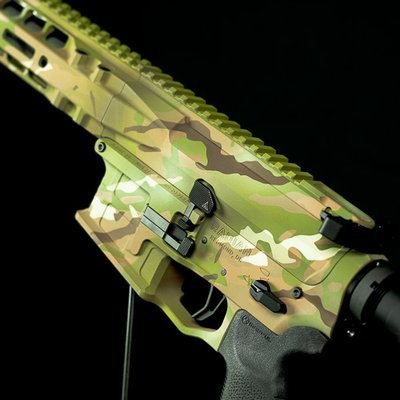What's the best gun finish?
What gun finish is best?
With a variety of firearm finishes available, it can be difficult to choose the right one. The best finish for your gun will depend on your specific needs and requirements, how you use your gun, and your personal style and taste.
To determine what finish would be best for your firearm consider the following needs:
Wear resistance/durability (especially for holsters)
Corrosion resistance—against water and chemicals
Appearance
In this blog, we’ll discuss gun finish options and the benefits of each. Check out the table below for a quick overview!
Cerakote
Cerakote is a ceramic-based paint that provides a durable layer, protecting against water, chemicals, and rust.
This finish is the most customizable with nearly unlimited color options. Because Cerakote is a paint, customers can choose a combination of colors, a custom design, or camouflage patterns.
Cerakote ranges in cost depending on how many colors the customer wants and the design or pattern requested. But unlike bluing or plating, surface prep is much more simple. Cerakoting requires sand blasting rather than hand polishing, meaning you don’t have to pay additional surface prep fees.
While Cerakote is highly resistant heat, it isn’t very resistant to abrasion, including holsters. Cerakote is the best finish for those who want to customize the look of their gun while also maintaining a corrosion resistant finish.
Bluing
Bluing is a traditional finish for firearms with a colorful layer that prevents rusting. In fact, the bluing process actually forms a layer of black rust (iron trioxide) to prevent red rust (iron dioxide) from adhering to the gun. Because of its tight molecular structure, black rust serves as an effective barrier for corrosive red rust.
By heating the metal and applying a chemical solution that reacts with the surface, a protective layer of black rust forms to create a barrier against the elements.
Bluing is a multi-step process that requires a lot of surface preparation. Every surface on the gun must be squeaky clean and consistently polished—removing any pitting or scratches. Oftentimes, more time is spent on surface prep than the bluing itself.
Bluing is a classic look that is well-suited for historical firearms or show guns. Because it’s not as durable as other finishes, it can be easily damaged by exposure to moisture or harsh chemicals and is therefore not recommended for heavily used guns. It is however more durable to abrasion than Cerakote, making it great finish for holsters.
Parkerizing
Like bluing, parkerizing is a chemical conversion coating. Unlike bluing, however, a parkerized gun is more resistant to chemical and water damage, abraision, scratches, and chips. With a dark gray, self lubricating layer of protection, parkerizing is a great finish for heavily used and holstered guns.
Scientifically, parkerizing is known as “phosphate conversion coating” or “phosphatization.” The gun is immersed in a chemical bath of phosphoric acid that reacts with the metal and raises the pH of near the surface of the gun. The phosphates near the metal surface become insoluble and are deposited onto the gun’s metal. This layer of phosphates provides a finish that is both durable and corrosion resistant.
Parkerizing is one of the best options for finishes since it is great for holsters and is resistant to water and chemical damage.
Nickel Plating
Nickel is a popular finish because of its bright, reflective appearance and its resistance to corrosion and abrasion. Nickel plating is often used on heavily used firearms. Because of it’s shiny and reflective appearance, many military and police forces do not want it for fear of giving away their position.
Black Nickel Plating
Prior to beginning the plating process, the gun must be completely clean and rust-free. Then, the gun is submerged in a electrolyte solution with dissolved nickel. When electricity is applied, nickel ions form, and the gun functions as a cathode, drawing the nickel ions to deposit on the metal surface. This process is called electroplating and creates a thin layer of nickel for a durable, long-lasting finish.
Nickel plating is a great shiny finish for those with heavily used or holstered guns that require chemical or water resistance.
Gold Plating
Gold plating is a luxurious finish that adds a touch of elegance to your firearm. In the gold plating process, the gun has to first be perfectly polished and clean before a thin layer of gold can be applied to the gun using electricity and heat. Often the polishing process takes hours of hand sanding and buffing before the gun is ready to be gold plated. This is because the firearm must be perfectly shiny otherwise, the finish will look matte gold instead of shiny gold.
Before adding the gold, the gun is electroplated with nickel so that rust doesn’t form underneath the permeable layer of gold. After submersing the gun in a thirty minute bath of electricity and dissolved nickel, the gun is ready for its gold finish.
Using the same method as the nickel plating, a thin layer of gold is electroplated onto the metal surface to create a bright, reflective finish. Unlike nickel, however, the gold plating only takes 30 seconds.
Gold plating is often used on high-end firearms and guns that aren’t used frequently. Because gold is a soft metal and isn’t resistant to water or chemicals, it’s not the best choice for firearms that will be subjected to heavy use.





